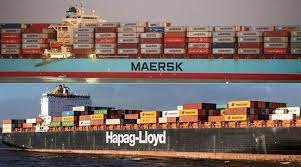The partnership between Maersk & Hapag-Lloyd will affect many countries around the world, as it will cover seven major trade areas involving Asia, Europe, North America, and the Middle East. Some of the countries that will be directly or indirectly connected by the new network are China, Japan, South Korea, India, Singapore, Malaysia, Indonesia, Thailand, Vietnam, Australia, New Zealand, United States, Canada, Mexico, Brazil, Argentina, Chile, Colombia, Panama, United Kingdom, Germany, France, Italy, Spain, Netherlands, Belgium, Denmark, Sweden, Norway, Finland, Poland, Russia, Turkey, Greece, Egypt, Israel, Saudi Arabia, United Arab Emirates, Oman, Qatar, Kuwait, Bahrain, Iran, Iraq, and Pakistan³. The partnership will also offer seamless connections to a wide range of transportation products and logistical services in these and other countries.

Some other major players in the container shipping industry in Maersk & Hapag-Lloyd are:
- COSCO Shipping Lines: The fourth-largest container line in the world, based in China, with a fleet of 495 ships and a capacity of 3.1 million TEU.
- Evergreen Marine Corporation: The sixth-largest container line in the world, based in Taiwan, with a fleet of 211 ships and a capacity of 1.6 million TEU.
- Ocean Network Express: The seventh-largest container line in the world, formed by the merger of three Japanese lines (NYK, MOL, and K Line) in 2018, with a fleet of 234 ships and a capacity of 1.8 million TEU.
- Zim Integrated Shipping Services: The tenth-largest container line in the world, based in Israel, with a fleet of 127 ships and a capacity of 640,935 TEU.
Some of the challenges of the container shipping industry in Maersk & Hapag-Lloyd are:
- Overcapacity: The supply of container ships exceeds the demand for shipping services, leading to lower freight rates and profitability for carriers¹².
- Fluctuating demand: The demand for shipping services is affected by various factors such as global trade, consumer sentiment, economic cycles, geopolitical events, and environmental issues, which create uncertainty and volatility in the market³⁴.
- Port congestion: The increasing size and number of container ships, coupled with the limited capacity and infrastructure of ports, cause delays and bottlenecks in the loading and unloading of cargo, affecting the efficiency and reliability of the supply chain.
- Fuel costs: The rising prices of fuel, which account for a significant portion of the operating costs of carriers, put pressure on their margins and competitiveness, especially in a low-freight-rate environment.
- Decarbonization: The shipping industry is under increasing scrutiny and regulation to reduce its greenhouse gas emissions and environmental impact, which requires carriers to invest in cleaner and more efficient technologies and fuels .
Key Takeaways for Maersk & Hapag-Lloyd
- Maersk and Hapag-Lloyd, two major container shipping companies, have entered into an operational cooperation that will cover seven major trade areas involving Asia, Europe, North America, and the Middle East.
- The partnership will directly or indirectly connect numerous countries, including China, Japan, South Korea, India, Singapore, United States, Canada, Germany, France, United Kingdom, Brazil, and many others.
- The collaboration aims to provide seamless connections and a wide range of transportation products and logistical services in these countries and beyond.
- Other significant players in the container shipping industry include COSCO Shipping Lines, Evergreen Marine Corporation, Ocean Network Express, and Zim Integrated Shipping Services.
- Challenges in the container shipping industry include overcapacity, fluctuating demand, port congestion, fuel costs, and the need for decarbonization.
- Overcapacity leads to lower freight rates and profitability, while fluctuating demand, port congestion, and fuel costs affect the efficiency and reliability of the supply chain.
- Decarbonization efforts and environmental regulations require shipping companies to invest in cleaner and more efficient technologies and fuels.
- The article emphasizes the complexities and ongoing efforts within the container shipping industry to ensure efficient and sustainable operations
conclusion
the operational cooperation between Maersk and Hapag-Lloyd in the container shipping industry represents a significant step towards enhancing global trade and logistics. By establishing seamless connections across major trade areas and connecting numerous countries, this partnership aims to provide efficient and comprehensive transportation and logistical services. However, the industry also faces challenges such as overcapacity, fluctuating demand, port congestion, fuel costs, and the imperative for decarbonization. To overcome these challenges and ensure long-term success, collaboration, innovation, and sustainability will be vital. By addressing these issues and working towards more efficient and environmentally friendly practices, the container shipping industry can continue to contribute to global economic growth while minimizing its impact on the environment.
hope this article was helpful and for more information check out our blog for previous posts by clicking here


